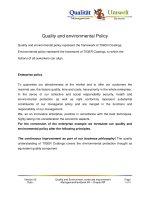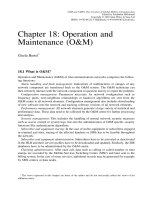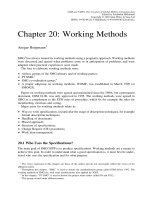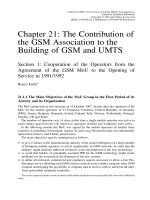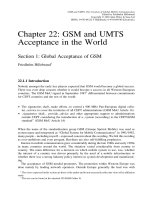Tài liệu GSM and UMTS (P22) doc
Bạn đang xem bản rút gọn của tài liệu. Xem và tải ngay bản đầy đủ của tài liệu tại đây (138.12 KB, 15 trang )
Chapter 22: GSM and UMTS
Acceptance in the World
Section 1: Global Acceptance of GSM
Friedhelm Hillebrand
1
22.1.1 Introduction
Nobody amongst the early key players expected that GSM would become a global success.
There was even deep concern whether it would become a success in all Western European
countries. The GSM MoU signed in September 1987
2
differentiated between commitments
for CEPT countries and the rest of the world:
†
The signatories shall...make efforts...to extend a 900 MHz Pan-European digital cellu-
lar...service to cover the territories of all CEPT administrations (GSM MoU Article 14)
†
..signatories shall... provide...advice and other appropriate support to administrations
outside CEPT considering the introduction of a...system (according) to the CEPT/GSM
standard’’ (GSM MoU Article 16)
When the name of the standardisation group GSM (Groupe Spe
´
cial Mobile) was used as
system name and interpreted as ‘‘Global System for Mobile Communication’’ in 1991/1992,
many people – including myself – expressed concern about this wording. We felt this wording
as over-ambitious and even arrogant. But there are also self-fulfilling prophecies.
Interest in mobile communication grew considerably during the late 1980s and early 1990s
in many countries around the world. The situation varied considerably from country to
country. The main difference for a decision on which mobile system to use, was, whether
the interest of a country was driven primarily by the need of a mobile infrastructure or
whether there was a strong industry policy interest in system development and manufactur-
ing.
The acceptance of GSM needed promoters. The promotion within Western Europe was
done mainly by leading network operators. Outside Europe generally the lead was with
1
The views expressed in this section are those of the author and do not necessarily reflect the views of his affiliation
entity.
2
The text can be found in the attached CD-ROM Folder D.
GSM and UMTS: The Creation of Global Mobile Communication
Edited by Friedhelm Hillebrand
Copyright q 2001 John Wiley & Sons Ltd
ISBNs: 0-470-84322-5 (Hardback); 0-470-845546 (Electronic)
globally active manufacturers who saw the chance of creating a world market for GSM, e.g.
Alcatel, Ericsson, Lucent, Motorola, Nokia, Nortel, Siemens. There were also efforts to
promote GSM by network operators with international ambitions, e.g. Deutsche Telekom,
France Telecom, Vodafone.
Seminars played a key role, organised under the auspices of the GSM MoU Group later
with participation of manufacturers’ associations. They provided a neutral discussion place
where interested parties in ‘‘ new’’ countries could meet key players and discuss with them.
These events often played a catalytic role in the GSM acceptance process. The most impor-
tant events are mentioned in Table 22.1.1.
The GSM MoU Group opened up in 1991 for non-European members by a revision of the
original MoU in an Addendum
3
. This opened up a basically European club for non-European
members.
With the greater number of non-European members a ‘‘ globalisation’’ was needed. To
achieve this, the GSM Association undertook during 1995 a complete review. This lead to the
GSM and UMTS: The Creation of Global Mobile Communication532
Table 22.1.1 GSM promotion seminars under the auspices of the GSM MoU Group
Date Location Purpose Co-ordination
12–14 October
1988
Hagen
(Germany)
To present the first GSM specifications
prepared for tendering of infrastructure
to a wide audience of operators,
manufacturers and academia
A. Silberhorn, P.
Dupuis, L. Kittel
(University of Hagen)
16–18 October
1990
Budapest
(Hungary)
To ‘‘ familiarise Eastern European
network operators with the GSM
standard and its inherent benefits’’ ,
‘‘ ...study the possibility of
implementation of...GSM...in Eastern
Europe’’
F. Hillebrand
June/July 1993 Prague (Czech
Republic)
To present the benefits of accepting
GSM and how to use GSM to several
Middle/Eastern European ministries
G. Schmitt
27–28 September
1994
Beijing
(China)
The provision of information to the
Chinese authorities: GSM services,
system, features and their evolution,
GSM acceptance in the world,
comparison between second generation
systems
F. Hillebrand
17–19 August
1994
New Delhi
(India)
Th provision of information to the
Indian authorities: SM standard,
security issues, regulation, licensing of
operators, planning and operation
F. Hillebrand
4–5 December
1995
Buenos Aires
(Argentina)
Promotion of GSM in Latin America F. Hillebrand
3
The text can be found in the attached CD-ROM Folder D.
removing of terminology like Pan-European System etc. from the GSM MoU. The member-
ship fee structure was reviewed, arising from both the growing globalisation of GSM and
ongoing interest in GSM as a wireless local loop candidate technology in addition to
†
cellular from lower GDP/ head countries. A balance needed to be struck
†
between the interests of these newer potential members (including in some
†
cases their higher relative scepticism to whether the roaming benefits could
†
be seen and the need for some of advanced services) and the more
†
traditional GSM operators who may have been involved for some time.
An appropriate set of compromises were reached and the original membership
†
fee structure was changed formally in 1996 to one based on a weighted GDP
†
per head basis, including an assessment of the number of competing
†
operators, so the burden could be shared within a given country, and
†
regional or local licensed footprints could also be taken into consideration
†
as well. This membership fee structure is still in place today and has
†
helped with the constructive development of membership throughout the globe.
The adoption of roaming and advanced services may not yet be everywhere, but
†
by holding the GSM ASSOCIATION together in this way the benefits are greater
†
overall for GSM customers and the industry as a whole.
22.1.2 Europe
22.1.2.1 Western Europe: 15 States Now in the European Union, Switzerland and
Norway
The GSM Memorandum of Understanding (MoU) was signed in September 1987 by 14
network operators from 13 countries. In November 1988 there were already 19 signatories
from 18 countries. These network operators committed themselves to open service to their
capital city and its airport in 1991. This agreement was a good starting point. But the
implementation was not easy.
The biggest problem was that manufacturers needed to be convinced that GSM was meant
seriously. This was achieved finally in autumn 1998 by the award of ten contracts to a number
of manufacturers for the supply of infrastructure. But this meant also that nine network
operators who had signed the GSM MoU had not ordered infrastructure in the autumn of
1988. In addition several of the ten contracts ordered only a validation system. There were
only two contracts with substantial quantities of infrastructure equipment, the contracts of
Deutsche Telekom and France Telecom. Both operators had decided not to implement a large
capacity analogue ‘‘ interim’’ system. These volumes were the first orders of large amounts of
real serial equipment.
GSM had a difficult competitive situation in the case of operators who had implemented
large capacity analogue ‘‘ interim’’ systems
4
GSM had an inferior coverage in the beginning.
Analogue hand-helds were available since the late 1980s. GSM hand-helds became available
in quantities in 1993 and were in the beginning bigger than advanced analogue hand-helds.
Chapter 22: GSM and UMTS Acceptance in the World 533
4
E.g. NMT900 in Scandinavia, the Netherlands, Switzerland and TACS in the UK, Italy and Austria.
The second wave of volume orders for serial equipment came from the new private
competitors who got GSM licences in the 1989/1990 time frame (e.g. Mannesmann Mobil-
funk in Germany, SFR in France, Omnitel in Italy) and the GSM 1800 operators in the UK
and Germany.
At this stage GSM created a much larger demand than the expansion of existing high
capacity analogue systems could cause. The strong development efforts of mobile station
manufacturers lead to an unexpectedly early appearance of several hand-helds already in
1993. Finally the superior services portfolio (including international roaming) and the higher
security lead to an energetic construction and expansion of GSM networks. Every GSM MoU
signatory had an operational GSM network in mid-1994. In Western Europe the number of
GSM subscribers passed the number of analogue subscribers in early May 1996 with 13.8
million each. Most analogue networks became irrelevant during the 1990s. Many were
switched off in 2000. At the end of 2000 only 2.3% of all European mobile subscribers
were still served by the analogue systems NMT and TACS.
22.1.2.2 Central and Eastern Europe
Strong promotion efforts of manufacturers and two seminars organised under the umbrella of
the GSM MoU Group (see Table 22.1.1) prepared the ground. All countries of the region had
an underdeveloped fixed network. Most countries rapidly issued two GSM licences. Large
network were developed in Hungary, Czech Republic, Poland, Romania and Slovakia (Table
22.1.2). Smaller networks exist in Albania, Belarus, Bulgaria, Bosnia, Croatia, Macedonia,
Moldavia, Montenegro, Serbia, Ukraine and other countries.
These networks had a growth which was much higher than forecasted. They played a
critical role to the economic recovery of these countries, since they rapidly provided a
powerful infrastructure for economic development. International roaming with Western
Europe was very attractive. The network operators attracted many talented people since
they offered future-proof new jobs. These licences attracted Western investors, who provided
capital and know-how.
Russia was in a more difficult situation due to the revolutionary changes of the economy
and the sheer size of the country. They issued only regional licences and small coverage
islands appeared. They achieved 2.2 million GSM users by the end of 2000.
GSM and UMTS: The Creation of Global Mobile Communication534
Table 22.1.2 Large GSM networks in Middle/Eastern Europe
Country Start of 2 GSM
operators
Users at the end of
2000 in millions
Hungary 1994 3.8
Czech Republic 1996 4.0
Poland 1996 5.2
Romania 1997 2.3
Slovakia 1997 1.3
The three Baltic states Estonia, Latvia and Lithuania found investors and know-how from
their Scandinavian neighbours and developed from 1993 to seven GSM networks with 1.5
million users at the end of 2000.
22.1.3 The Arab World
The Arab countries (about 40) share one language and they communicate intensively amongst
themselves. Therefore GSM was very attractive, since it was the only system offering fully
developed proven international roaming. Another attractive feature for the country leaders
was the high level of protection against eavesdropping and unauthorised use. During the
1990s telecommunication was a monopoly in all Arab countries. This also included mobile
communications.
The acceptance of GSM started by an agreement between the Gulf states in the Gulf Co-
operation Council to adopt GSM in the early 1990s. Etisalat (United Arab Emirates) was the
first operator from the region who applied for membership in the GSM MoU Group, already
in May 1991 (MoU#16). Their manager Hatim Lutfi was the first overseas participant in a
MoU meeting at MoU#17 in September 1991 in Brighton. The Gulf states planned to become
a services and trading centre for the region in the period after the exhaustion of the oil.
Therefore they invested heavily in telecommunication infrastructure and were interested in
becoming leaders in GSM in the Arab World.
The second phase was the agreement of the Arab League to adopt GSM in 1992. Within the
framework of an ITU project called MODARABTEL, the Arab League had established a
Telecom office in Tunis. In 1993 Nina Danielsen, a GSM expert from Norway was posted in
this office. One of her achievements was the preparation of a workshop open to the mobile
communication experts of all Arab countries. This workshop took place in Amman on the 22-
25 November 1993 and was extremely successful. This contributed to a blossoming of GSM
networks in many Arab countries, e.g. Saudi Arabia, Egypt, Jordan, Syria, Algeria, Tunisia,
Lebanon, Morocco. Today all the Arab countries have a GSM network.
GSM provides to mobile users a seamless infrastructure for the Arab World. In total 10
million people used GSM at the end of 2000.
22.1.4 Asia Pacific
22.1.4.1 Australia, New Zealand and Pacific Islands
Australia’s regulator Austel was the first non-European organisation which applied for
membership in the GSM MoU Group in February 1991 (MoU#15) since it had decided to
implement GSM. The Australian regulatory authority had thoroughly reviewed all available
analogue and digital alternatives. The Australian incumbent operator had an analogue AMPS
network. The regulator wanted modernisation and competition of at least two operators for
the incumbent. Therefore it was decided to go for a digital system. GSM was seen as superior
to other alternatives. A serious disadvantage for the analogue and digital systems developed
in the US was, that they allowed only two operators to compete in a given area.
New Zealand successfully implemented a GSM network very early.
Vodafone acquired a licence in Fiji. The French operators covered the French overseas
territories in the Pacific.
Chapter 22: GSM and UMTS Acceptance in the World 535
22.1.4.2 The Asian Tiger States
South Korea was driven by a strong industry policy interest in developing and manufacturing
their own system. They acquired licence rights to CDMA ANSI 95 radio transmission
technology and became a leader in that technology. GSM was not admitted. Korea achieved
a penetration of the home market of 41%. But they are isolated from the world in the second
generation. They have drawn conclusions from this experience for their third generation plans
and are active members of 3GPP, at least for the terminal and radio part.
Singapore and Hong Kong had a liberal regulation regime. In both states networks with
different technologies were implemented by several operators. In both cases GSM was the
clear winner of the competition. This is especially remarkable in Hong Kong with its difficult
radio coverage situation (skyscrapers, sea, mountains). Here GSM took 84% of the market in
1999 (Table 22.1.3).
In Taiwan the incumbent operator implemented GSM 900 very early. Then competitors and
GSM 1900 operators were licensed. Taiwan reached 17.6 million users by the end of 2000.
Also Malaysia successfully licensed several GSM 900 and 1800 operators.
22.1.4.3 China
The GSM promotion activities were mainly done by many major manufacturers who were
already active in China in fixed or even mobile communications. The first success was the
GSM network in the southern province of Guangdong, an industrialised special zone. They
became indeed the first Chinese signatory of the GSM MoU. Guangdong was to my mind
seen by the Chinese Ministry of Post and Telecommunications (MPT) as a test case.
There were intensive promotional activities of the two main groupings in 1993/1994:
†
‘‘ CDMA’’ : ANSI95, lead promoter Qualcomm
†
‘‘ GSM’’: promoted mainly by Alcatel, Ericsson, Nokia and Siemens
The MPT invited several field trials in early 1994. Qualcomm declared victory for ANSI 95
CDMA in a very aggressive seminar in spring 1994.
The GSM ‘‘ camp’’ provided a lot of information, but it became clear, that a bigger effort
was needed. So the idea of a GSM promotion seminar under the auspices of the GSM MoU
Group was born (see Table 22.1.1). I worked at that time for the GSM MoU Group and was
charged with arranging such a seminar. Richard Midgett and his colleagues from Hong Kong
GSM and UMTS: The Creation of Global Mobile Communication536
Table 22.1.3 Distribution of mobile users between competing standards in Hong Kong
System Subscribers
in millions
(end of 1999)
Share in %
GSM 3.4 86
ANSI54 0.05 1
ANSI95 0.51 13
Total 3.96 100


